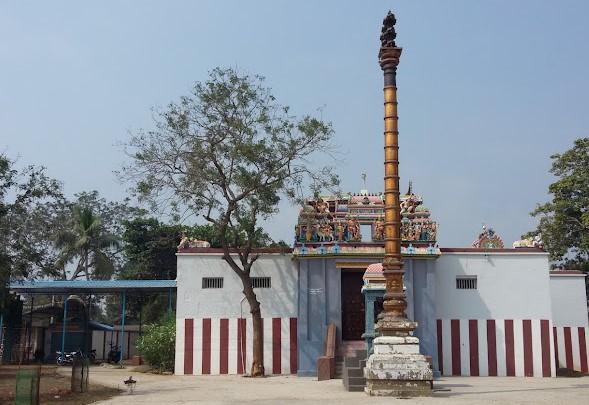- The Sri Oontreeswarar Temple was originally located on the banks of the Kusashthalai River in a village called Thiruvulampudur. In 1942, the Tamil Nadu Government acquired and took over several villages, including Thiruvulampudur, for the construction of the Poondi Water Dam. As a result, the original temple was relocated to an alternative site in Thiruvenpakkam (Poondi).
- The Government provided land in Thiruvenpakkam for the construction of a new temple. The idols of deities, except the Moolavar, along with the pillars and sculptures from the old temple, were carefully removed and reinstated at the new location. However, the idol of the main deity was newly created, as the original idol had already been installed at the Sri Gangadareswarar Temple at Purasapakkam, Chennai.
- The Maha Kumbabishekam (consecration ceremony) for the new temple at Thiruvenpakkam (Poondi) was held on 5th July, 1968.
- It is said that a portion of the old temple’s main tower can still be seen from the banks of the Poondi Lake, serving as a reminder of the temple's original location at Thiruvulampudur.
PURANIC SIGNIFICANCE:
The Legend of Saint Sundarar's Journey from Thiruvotriyur to Thiruvarur
Saint Sundarar, a devoted follower of Lord Shiva, left Thiruvotriyur to proceed to Thiruvarur after abandoning his wife, Sangili Nachiyar, and breaching the promise he made to her. This act, driven by his desire to move forward in his spiritual journey, led to significant consequences.
The Marriage of Saint Sundarar and His Promise to Sangili Nachiar
Saint Sundarar, a prominent Nayanar saint, was married to Paravai Nachiar in Tiruvarur. However, he also married Sangili Nachiar in Tiruvottriyur, a devoted Shiva worshiper. As part of the marriage vows, Sundarar promised Sangili Nachiar that he would never leave her side. Lord Shiva Himself witnessed this vow and the marriage.
Loss of Vision and the Encounter with Lord Shiva
As Sundarar journeyed toward Thiruvarur, he lost his vision, a consequence believed to be the result of his failure to keep his promise to Sangili Nachiyar. Upon entering the temple, he expressed his frustration to Lord Shiva, asking in annoyance, "Are You really here in this temple (Koilul ullayo?)" He further questioned the purpose of the Lord’s presence if He could not solve the problems of His devotees.
Lord Shiva’s Response: A Walking Stick
Despite Sundarar’s plea for the restoration of his vision, Lord Shiva responded with a calm and polite reply, saying, "Yes, I am inside (Ulom Pokeer)," but instead of restoring his sight, He handed Sundarar a walking stick. The Lord asked Sundarar to continue his journey using the stick, a gesture that disappointed and angered the saint.
Sundarar's Unyielding Devotion and Appeal to Lord Shiva
Despite the lack of response, Sundarar remained steadfast in his devotion. As he continued his journey towards Tiruvarur, he came to a place where he repeated his appeal to Lord Shiva, asking for his vision to be restored. But Lord Shiva remained silent, showing no immediate response to his prayers.
The Stick of Support and Sundarar's Frustration
Sundarar, undeterred by the silence of the Lord, asked with unwavering faith, “If You are truly here, Lord, grant me my vision.” Out of compassion for his ardent devotee, Lord Shiva provided Sundarar with a walking stick, instructing him that with the stick, he could proceed further on his journey. Lord Shiva, though sympathetic, did not restore Sundarar's vision directly. This act of the Lord symbolized the four forms of devotion, or Bhakti, which are:
- Satputra Marga – The devotion of a son.
- Dasya Marga – The devotion of a servant.
- Mathura Marga – The devotion of a lover.
- Saka Marga – The devotion of a friend.
The relationship between Arjuna and Lord Krishna exemplifies Saka Marga, which is characterized by devotion between a friend and the Divine. In this context, Sundarar sought a similar relationship with Lord Shiva, desiring to be treated as a friend by the Lord.
Sundarar’s Anger and the Breaking of Nandi's Horn
In a fit of anger and dejection, Sundarar threw the walking stick back, and it struck the right horn of Nandi, the sacred bull of Lord Shiva. The impact caused the horn to break. As a result, both Saint Sundarar and Nandi’s idol are depicted in the temple: Sundarar with closed eyes and a sad expression, holding the walking stick in his left hand, and Nandi with the right horn broken. These idols stand before the shrine of Lord Shiva, symbolizing the emotional turmoil of Sundarar’s devotion and frustration.
Goddess Parvathy’s Help: Minnoliyammai and Kanivai Mozhi Nayaki
As Sundarar continued his journey, Goddess Parvathy, the consort of Lord Shiva, is believed to have helped him by providing light through flashes of lightning along the way. This is why she is praised as "Minnoliyammai" (meaning "the one who gives light," with "Minnal" meaning lightning in Tamil).
Additionally, Goddess Parvathy is also referred to as "Kanivai Mozhi Nayaki" – the goddess who assured Sundarar that life follows one’s karma (good or bad deeds) and that he would regain his vision in due course. This reassurance comforted Sundarar, and he continued his journey with hope.
Sundarar’s Spiritual Journey and Healing
Saint Sundarar's journey, though filled with emotional turmoil and physical blindness, was ultimately a path of spiritual growth. His devotion, despite challenges, remains a powerful testament to faith and perseverance.
Prayers for Relief from Life's Struggles
This temple is believed to help devotees suffering from depression, lack of direction in life, or challenges in professional development. Prayers to Lord Shiva at this temple are said to offer relief from such struggles, just as Sundarar was assured by Goddess Parvathy that time would heal his suffering and restore his sight.
Sundarar's Sad Departure Towards Kancheepuram
After the incident, Sundarar, feeling saddened and defeated, continued on his way towards Kancheepuram, leaving behind the place where his appeal had gone unanswered. The episode highlights Sundarar’s intense devotion, his frustration with the divine silence, and the complex, multifaceted relationship between a devotee and the Divine.
Oondreeswarar:
Saint Sundarar married Paravai Nachiyar in Tiruvarur. He also married Sangili Nachiyar in Thiruvottriyur who was a staunch Shiva devotee and promised her that he won’t leave her. Lord Shiva was witness to the marriage and the promise. Sundarar breached his promise and proceeded to Thiruvarur. While he was crossing the borders of Thiruvottriyur, he lost his vision. He understood that he was punished for violating his promise and appealed to Lord Shiva. Lord did not respond to the prayer.
Sundarar proceeded to Tiruvarur facing all struggles and came to this place on the way and repeated his appeal to Lord for vision. Lord Shiva kept mum but Sundarar was unrelenting. He asked the Lord whether he was really there and if so “give me my vision.” Lord, though sympathized with his fond devotee, gave Sundarar just a walking stick (Oondru in Tamil) saying that he was there only and he could proceed with the help of the stick. Hence he came to be known as Oondreeswarar.
Sundarar demanded that the Lord should grace him as a friend but the Lord was unyielding. Sundarar became angry and argued with the Lord loudly but in vain. In a fit of anger, Sundarar threw the walking stick granted to him which hit the right horn of Nandhi breaking it. Sundarar proceeded sadly towards Kancheepuram. In this temple, Sundarar holding a pole adjacent to Nandi with the broken horn are found.
Minnoli Ambal:
Mother Minnoli Ambal was ready to accompany blind Sundarar struggling to walk with his stick but Lord Shiva prevented her from doing so. Indicating this event, we see the left leg of Mother in a forward motion. Mother told Sundarar that life goes in accordance with one’s good or evil deeds. “Though you have lost your vision now, you will regain it shortly with the grace of the Lord” She assured Sundarar. She guided Sundarar on his way to Kanchipuram from this place, Parvati appeared as a lightning in front of him, giving the name of Minnoli Nayagi (Minnoli indicated lightning in Tamil). Hence, Mother is worshipped as Minnoli Ambal and Kanivai Mozhi Nayaki – Mother with assuring words.
ADMINISTRATION:
The temple is administered by the Hindu Religious and Charitable Endowments (HR&CE) Department, a government body that manages and oversees the functioning of Hindu temples in Tamil Nadu.


